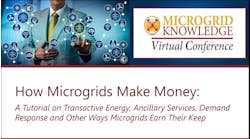Utilities are eyeing hybrid microgrids – which include hydrogen and other sources of renewable energy – to meet their decarbonization goals, respond to sustainability concerns from commercial and industrial customers, integrate renewable energy and provide resilience for customers.
Depending on the state, utilities have to comply with an array of decarbonization policies, said Mark Feasel, executive vice president and chief commercial officer at FuelCell Energy. In some cases, they’re shifting the composition of their generation, eliminating coal or moving away from natural gas.
To meet their decarbonization goals, utilities are adding more solar and wind energy, which can pose challenges because they’re intermittent resources. Utilities are also thinking about introducing hydrogen for long-term storage that helps firm up wind and solar.
“Instead of turning off solar and wind, they can feed those resources into a fuel cell or electrolyzer, and make and store hydrogen,” explained Feasel. “It will become long-term storage.” This allows utilities to monetize solar and wind, rather than turning away excess renewable resources.
And hydrogen can help for longer periods than batteries; after four hours, hydrogen is less expensive than batteries, said Feasel.
New business models
Utilities are now looking at new business models that would allow them to take advantage of the benefits of hydrogen, he said. And utilities are expected to be partners in most Department of Energy hydrogen hub projects, which are designed to increase both supply and demand for hydrogen. For example, Xcel Energy is vying for some of the $8 billion in federal funds available through the hubs. Clean hydrogen hubs are expected to create networks of hydrogen producers, consumers and infrastructure to accelerate the use of hydrogen as a clean energy carrier that can provide or store large amounts of energy.
Two utilities – Pacific Gas and Electric (PG&E) and Southern California Gas (SoCalGas) – are deploying hydrogen in microgrids to meet decarbonization goals and help provide resilience during California wildfire season, which often prompts public safety power shutoffs (PSPS).
Hydrogen for homes
SoCalGas is focusing on demonstrating how clean, renewable hydrogen can be used in residential microgrids.
In February, SoCalGas turned on its [H2] Innovation Experience, a 2,000 square-foot home powered by a renewable hydrogen microgrid.
Located in Downey, California, the [H2] Innovation Experience is the first home in North America where a state-of-the-art solar powered renewable hydrogen microgrid provides electricity to the home 24 hours a day, 365 days a year.
The project demonstrates how clean, renewable hydrogen microgrids can power entire neighborhoods throughout the year, said Neil Navin, chief clean fuels officer at SoCalGas, during a keynote address at the Microgrid 2023 conference in Anaheim, California.
Clean fuels networks that include hydrogen can provide added resiliency for utilities, especially through fuel storage and local generation for microgrids, said Navin. Such networks can be especially helpful in fire zones, dense urban areas and for serving critical loads such as hospitals and emergency services, he added.
“When we think of microgrids, we typically think of solar power, wind power and battery storage,” Navin said. “But I’m here today to highlight clean, renewable hydrogen as a viable fuel source with the enhanced benefits of energy reliability and resiliency.” Electrification along with clean fuels and carbon management provide the most affordable, resilient and technological proven route to carbon neutrality, he said.
“In fact, the findings show that California can reach its net-zero goals more affordably, more equitably and with less risk of power disruptions and customer conversion barriers by leveraging the existing gas system to deliver clean fuels and to manage carbon,” said Navin.
Calistoga Resiliency Center
Through its hydrogen microgrid project, PG&E hopes to provide resilience to a Northern California substation, the Calistoga Resiliency Center (CRC), that is subject to PSPS sparked by wildfires. The California Public Utilities Commission recently approved the company’s proposal for an 8.5-MW microgrid developed by Energy Vault.
The green hydrogen used at the Calistoga Resiliency Center is produced through an electrolysis process powered by renewable energy or nonfossil feedstock resources that are compliant with California’s Renewable Portfolio Standard, said Marco Terruzzin, chief commercial and product officer at Energy Vault.
Under the 10.5-year agreement, Energy Vault will provide “distributed generation-enabled microgrid services,” a type of energy service that uses grid-forming generation and storage resources, potentially in combination with demand-side resources, to provide energy, fault current contribution, and voltage and frequency regulation to aid in the islanding of the microgrid during outages, said Terruzzin.
“This renewable green hydrogen is delivered to the on-site liquid hydrogen storage tank. When a public safety power shutoff event is requested, the CRC springs into action by feeding the hydrogen into fuel cells, which generates emission-free electricity,” he said.
The system’s lithium-ion batteries will utilize their fast-ramping capabilities to ensure the CRC’s power supply matches demand.
The microgrid will serve a section of the PG&E grid that’s capable of islanding from the larger grid.
Designed to operate during planned outages and PSPS, the microgrid will serve all the load within a “safe-to-energize” area in the city of Calistoga, including fire and police stations and shared services in the downtown and surrounding area, said Terruzzin.
Montgomery County, Maryland, is also embracing the green hydrogen trend with a microgrid project that uses the fuel but also produces and possibly sells it. The 7-MW microgrid project is a joint venture of Schneider Electric and financial giant Carlyle.
One of the goals is to reduce high demand charges when the depot phases out compressed natural gas and instead uses 70 electric and 70 fuel cell buses. The hydrogen for the fuel cells will come from a 1-MW green hydrogen production plant that will be built on-site.
Nuclear and hydrogen play
Utilities that have nuclear power in their mix are looking to co-locate nuclear power plants and hydrogen facilities, said FuelCell’s Feasel. He has been talking to some of the utilities that own the biggest nuclear power plants, and they say hydrogen will boost the efficiency of their nuclear units.
“If you co-locate nuclear power plants and hydrogen, you get synergy and efficiency by adding heat,” he said. That drops the levelized cost of hydrogen.
Such utility and industry adoption of green hydrogen will be the key to creating a vibrant hydrogen market, said Feasel.
“I expect consumers to play a major role in the ecosystem, which will mean that microgrids will be vital,” he said.
Track news about microgrids. Subscribe to the free Microgrid Knowledge newsletter.








